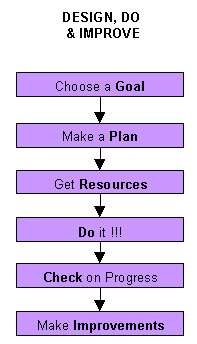![]()
Other topics
The process below was developed with a Grade 4 class (10 year olds) at Riverside Primary School in 1998. It is the class' response to the question:
"Can
we make a general recipe to achieve any goal?"
In fact this process is generic to any purposeful, thoughtful activity. But sometimes other demands can make us less thoughtful.
Shortly after the class devised the process, RPS was visited by a teacher from another school who was trying to answer the question, "How does RPS manage its Professional Development budget?" (Schools receive specific cash allocations for this purpose; notice the focus is on the budget rather than professional development).
The visitor was trying to start with Step 3 - the resources provided. She failed to distinguish between the resources provided and the resources available- indirectly promoting dependency.
Then she wanted to go to Step 2, the purpose of the visit was to find out about the RPS plan. But RPS regularly achieves higher levels of outcomes and independence by keeping to its more comprehensive process, only part of which is a plan.
Even when the visitor's approach got to Step 1 it would have resulted in less than what was actually possible. It changed from identifying the school's goals to choosing the goals that could be matched to the resources, eliminating some goals from the plan because they were too costly and others because they were not related to money at all, and so on.
Fortunately the visitor had a good sense of humour and was quite amused when she heard how the Grade 4s would have approached her task.
RPS, on the other hand, goes through the process steps in order; it uses an agreed process. The cash allocation is only one of the resources used for professional development (and a small part at that !!!). The School is clear about its goals and has a large professional development program worth (but not costing) many times the official allocation.
Note: This true story illustrates a common danger of financial 'accountability', viz, that when the focus is on the expenditure of the finance, rather than on the value of what has been achieved overall, the value gained is likely to less rather than more. The assumption is that professional development is a zero-sum system (you only get what you pay for) rather than a surplus generating system, which of course it is, at least potentially.
![]()